Characteristics and influence on a person
Pistachio color is a soft and refined shade of green. It is easy to guess that it got its name in honor of the “lucky nuts” – pistachios. Like the color range of the nuts themselves, the shades of pistachio vary from light to dark, can go to warmer or colder.
But all these variations still have a common feature: a yellow undertone. After all, to get a natural color, you should mix 5 parts green and 3 parts yellow.
The main feature of the pistachio interior is that it is suitable for decorating any room, children and adults, men and women like it, and most importantly, it has a calming effect on the psyche and creates a comfortable atmosphere.
Even an excess of color will not look too much, so it is acceptable to create a monochrome design using different shades.

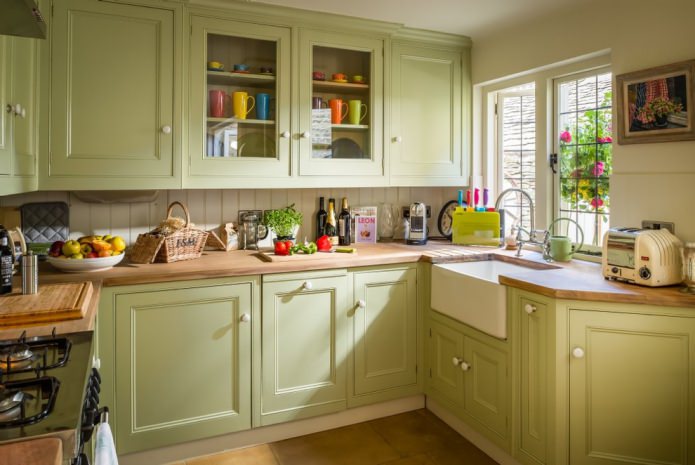

Variety of shades
Due to its natural origin, the pistachio range is represented by a wide range of shades. You can find various variations in interior design – from delicate pastel tones to rich and deep. Such diversity ensures its versatility and makes it an excellent tool in the hands of a designer.
Varieties of shades:
- Light pistachio. It is obtained by adding 20-30% white color to standard paint.
- Pale shades are better suited as a background, but can be used in accents and furniture.
- Dark pistachio. The same 20-30%, but black color, is added to the base. The deep tone is ideal for accents, textiles, accessories.
- Gray-pistachio. With an excess of gray, it can look dirty, but with a harmonious combination, a pleasant cold undertone is obtained.
- Yellow-pistachio. Warm, sunny, pleasant shade. The ratio of ingredients is approximately 5:5. Ideal as a replacement for green in northern rooms.
- Green-pistachio. The freshest representative of the palette: the ratio here is not 5:3, but 7-8:3. It reminds me of the color of green tea, it calms and relaxes perfectly.

The photo shows shade options
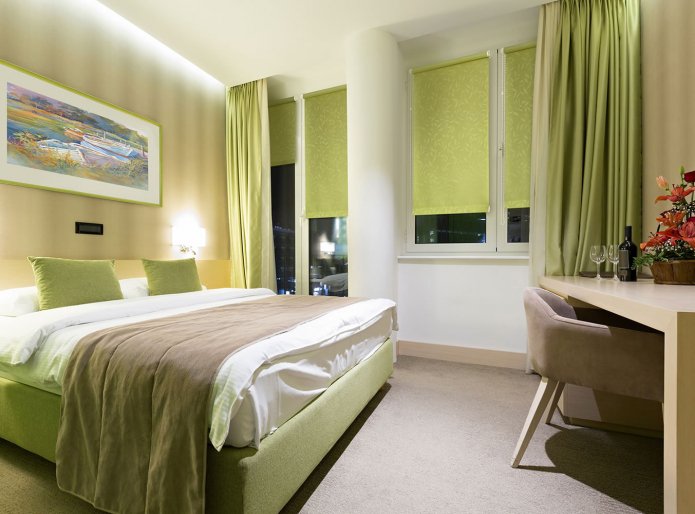
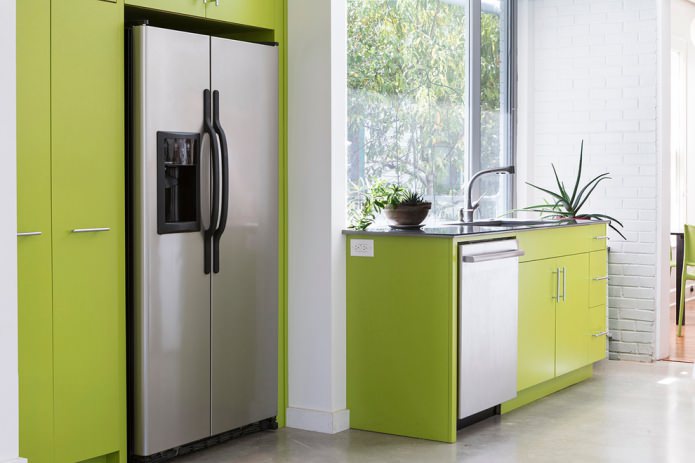
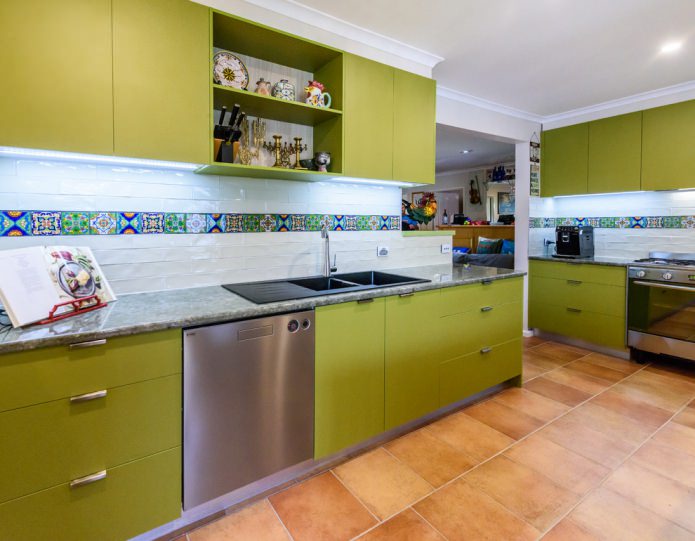

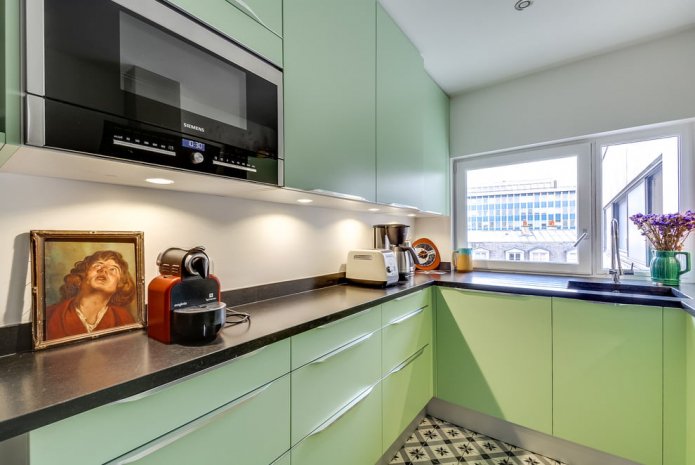
What colors does it go with?
Pastel shades of pistachio have a unique characteristic: they go with almost all colors of the palette. Below I will tell you about the most popular combinations that will look very stylish. Among them there will be neutral and contrasting combinations – choose the option that suits you best.
White. Pistachio and white colors look fresh and modern together. Snow-white reveals green nuances of pistachio, renews it.


Beige. A classic duo, often used in the classic or Provence style.

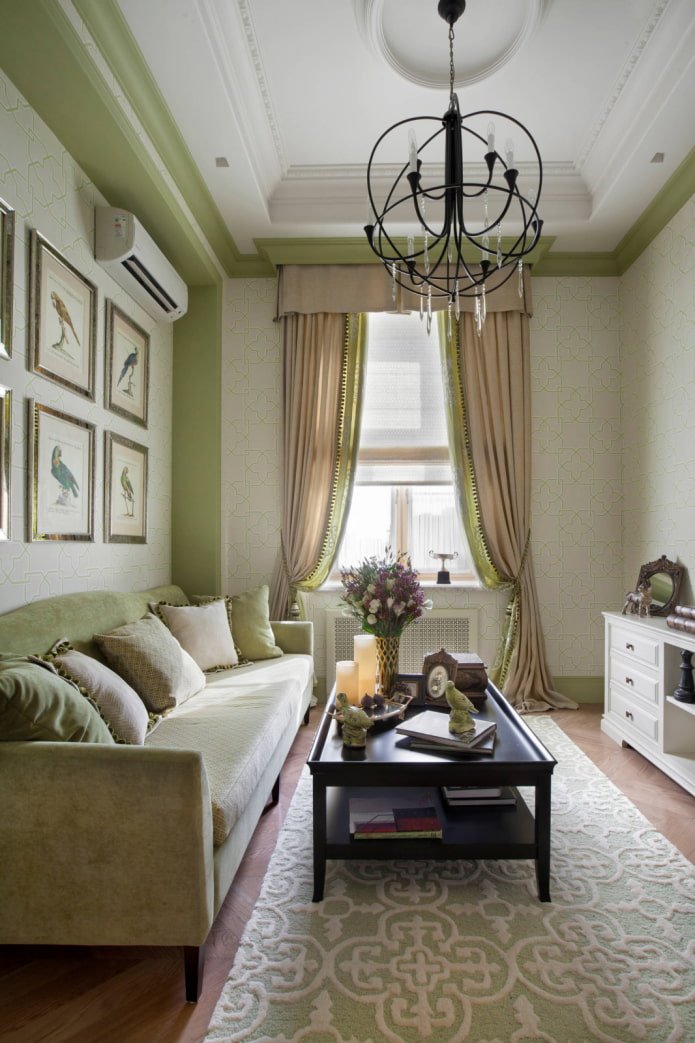
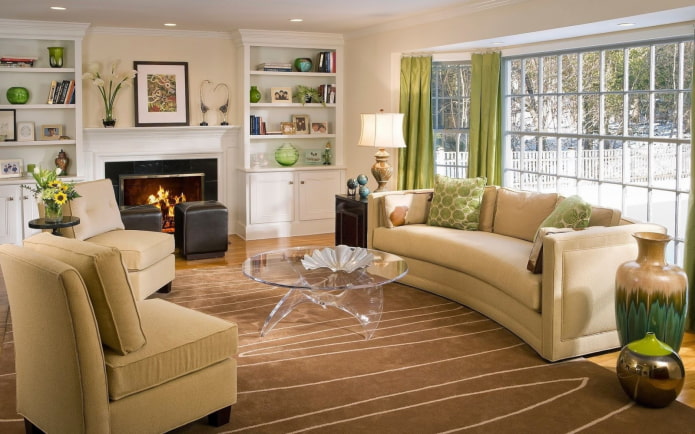
Brown. Rich coffee and natural chocolate, like the previous version – a classic of the genre. One of the frequent applications is a kitchen set with a brown bottom and a green top.

Gray. Dark pistachio in combination with dark gray will look bright, but not contrasting – an ideal solution for bedrooms, living rooms.
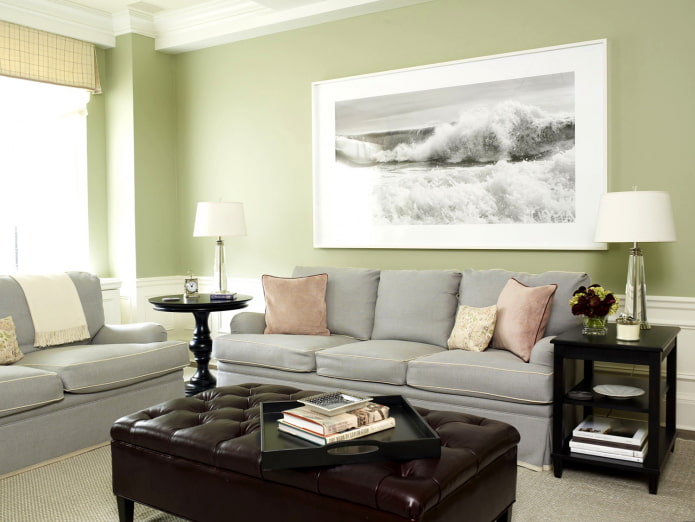
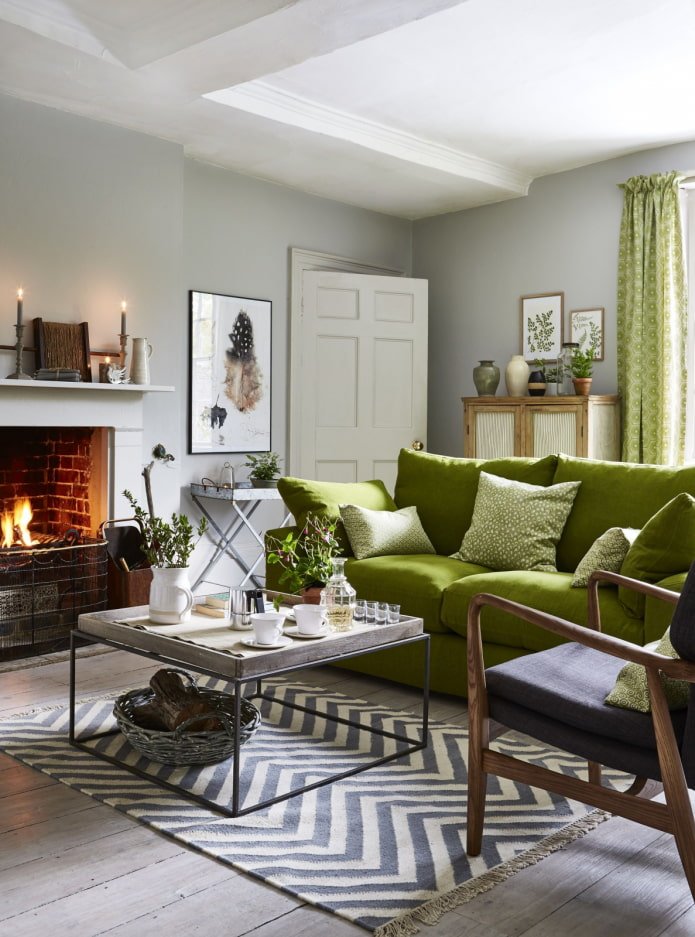
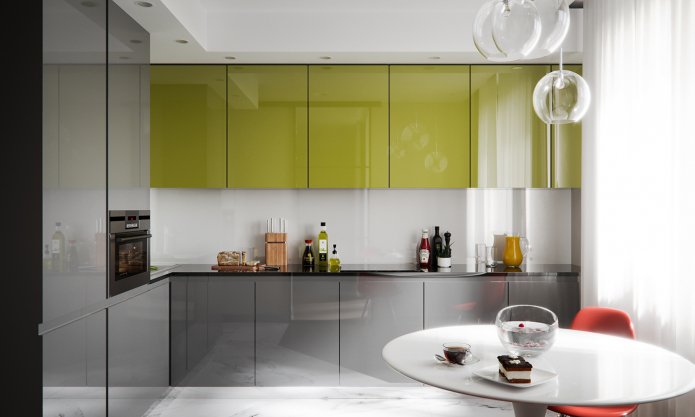
Black. More prim than brown, not adding unnecessary notes to the design.
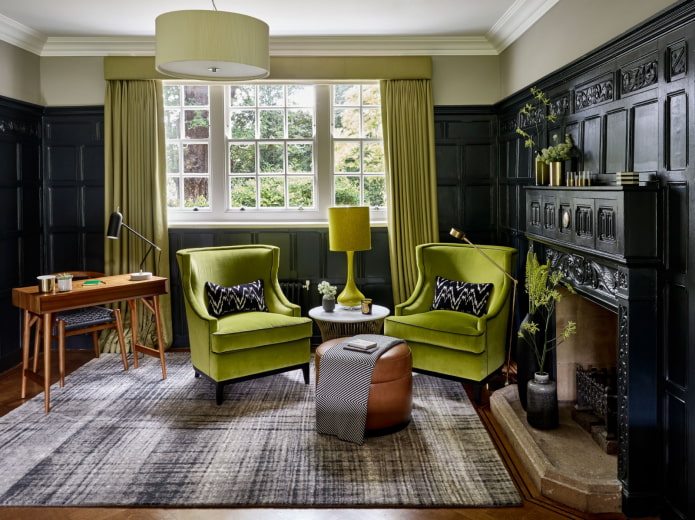
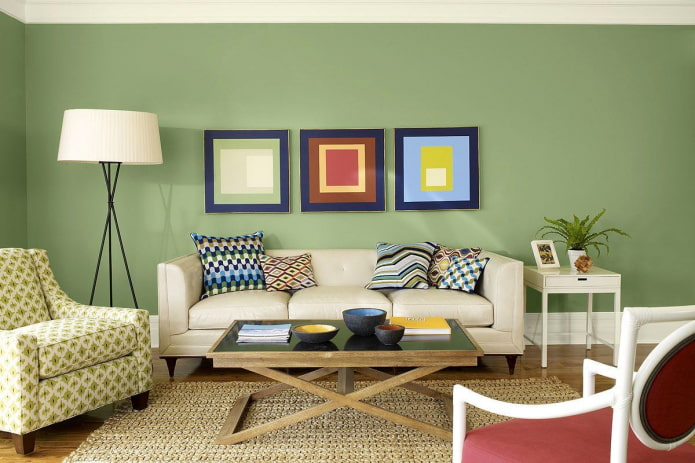
Purple. Complementary to yellow, so more suitable for a warm, soft pistachio color.
Red. Opposite green, looks best in a duet with cool shades.
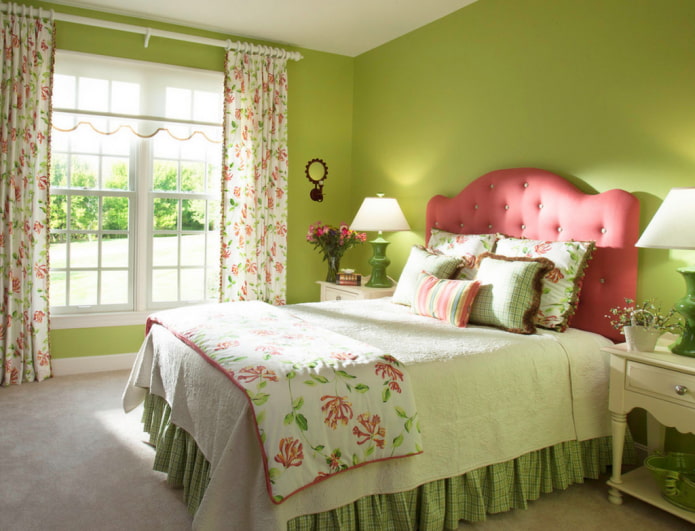
Blue and light blue. They should be combined according to saturation: light blue with a light shade of pistachio, blueberry with a dark one.
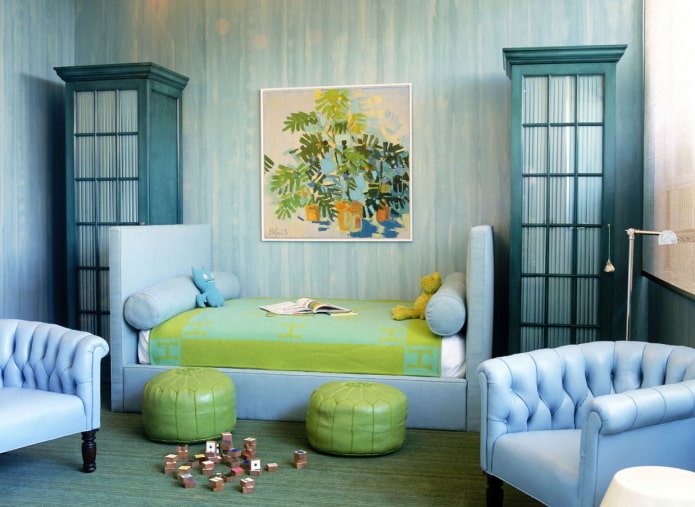
There are also halftones: pink, peach, turquoise or purple. Individual shades of pistachio also go well with them, but a more complex approach is required to make the combination look harmonious to the eyes.

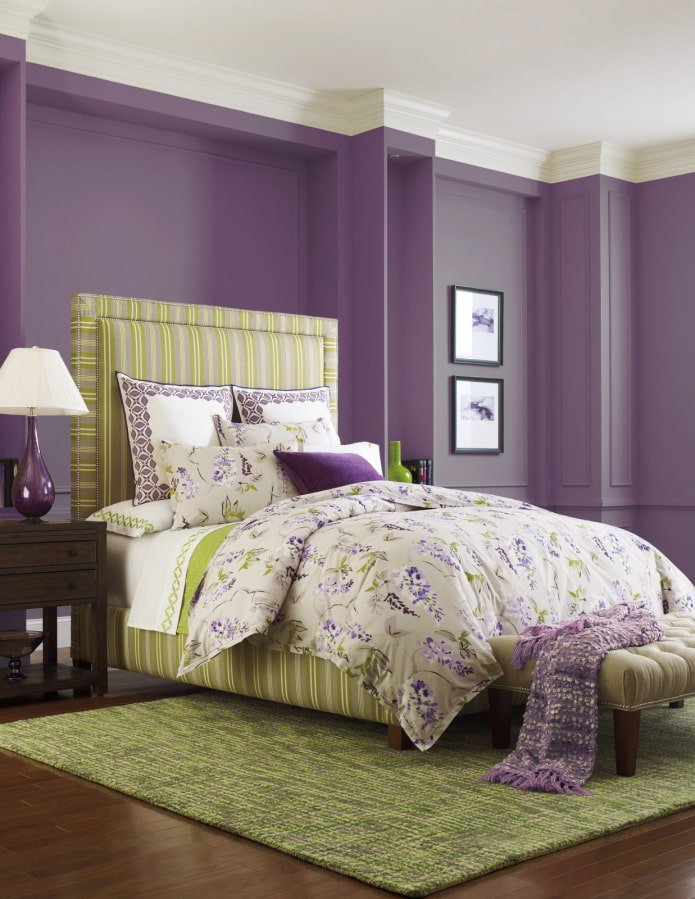
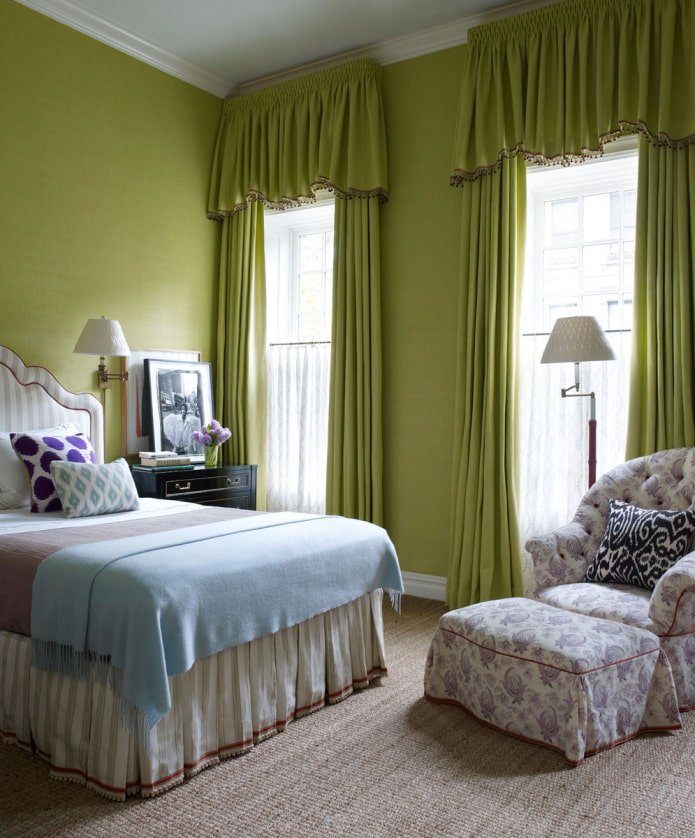
How does it look in decoration?
Pistachio wall color is a great alternative when basic white, gray or beige is already boring. Light green looks intriguing and neutral at the same time, it doesn’t get boring or irritating.

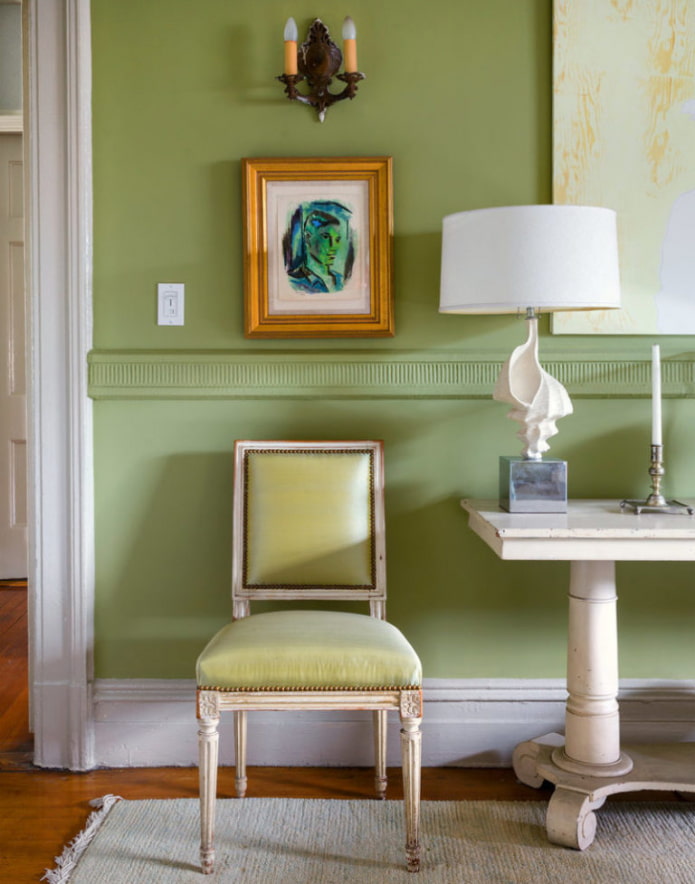
For large surfaces (cover all 4 walls), bleached halftones are best. When decorating an accent wall, it’s better to use dark, saturated variations. The other walls can be either light beige or dark gray. For finishing materials, choose paint or minimalist wallpaper.
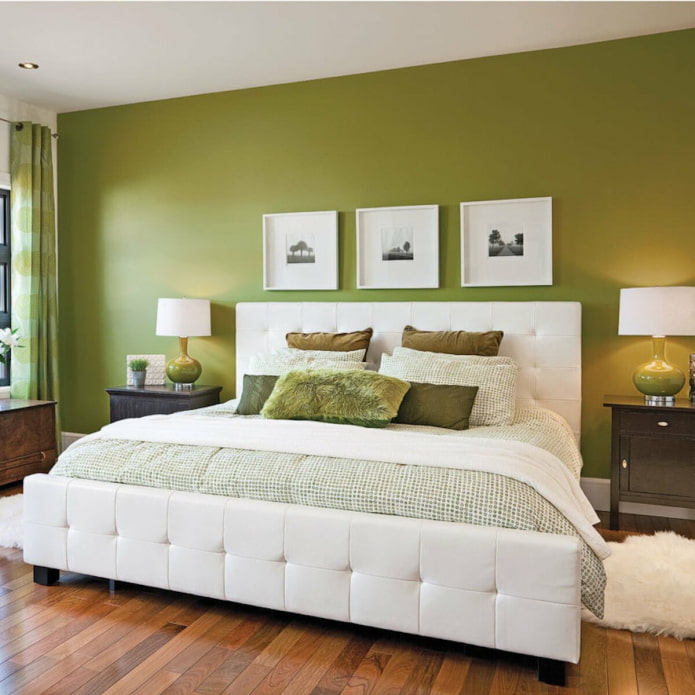
Pistachio is so versatile that it is even suitable for the ceiling: in combination with cream or milky walls, you get a delicate, pleasing to the eye finish. However, it is rarely used as a continuous ceiling covering. Rather, you will find partial finishing with moldings or combined options.
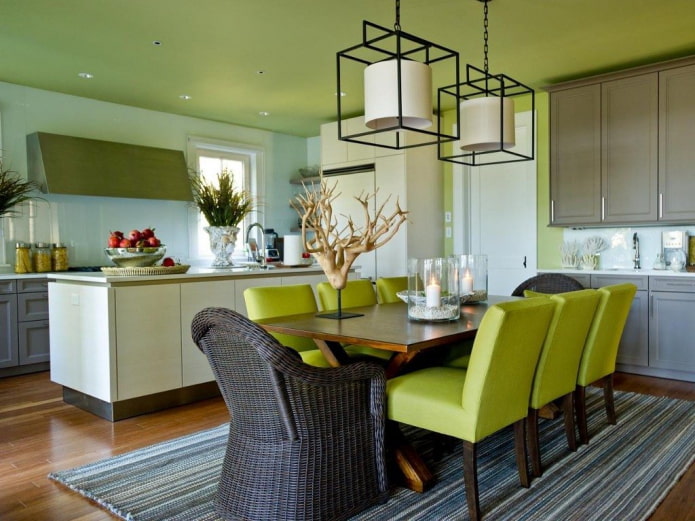
Pistachio is rarely used to create a floor covering and in most cases it will be carpet or a classic rug.
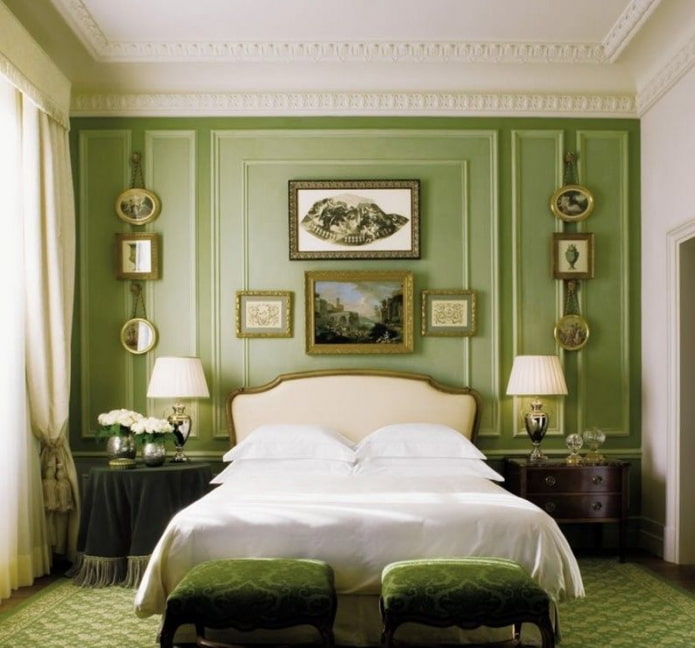
The natural tone is also used in the exterior: for the external cladding of the house, for example. It goes well with grass and trees, and in winter the facade will look warm and spring-like.
How to use pistachio furniture in the interior?
Pistachio furniture is presented as both cabinet and upholstered items. Light green upholstery harmonizes with warm light textiles (pillows, blankets, carpets) and milky walls. Dark looks better surrounded by black or gray elements.
The sofa will decorate the living room in the style of Provence, classic, eco. The combination with textured wood and live plants allows you to turn an apartment in the city center into a corner of living nature.
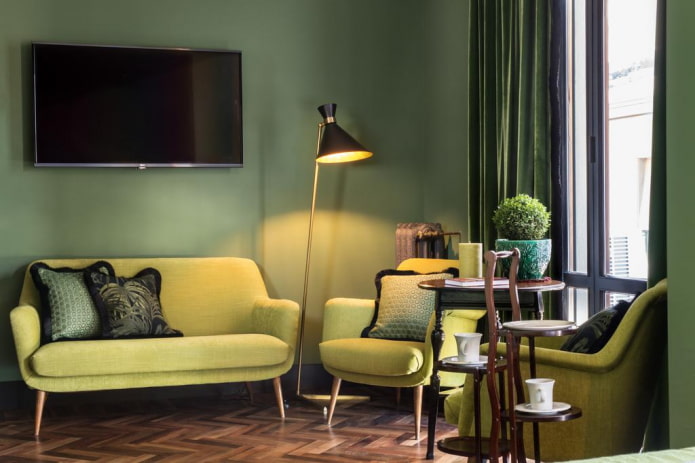
In the bedroom interior, a soft pistachio headboard is often used. To make the design look harmonious, combine it with curtains, lampshades or other decor.
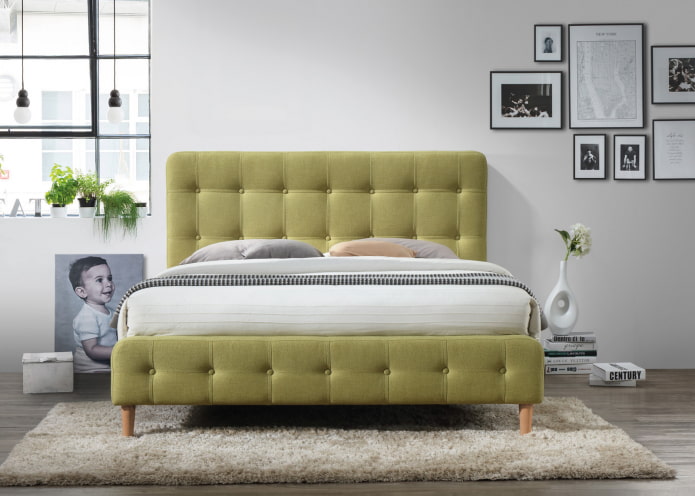
The color looks equally good in fabric (burlap, chenille, velor), as well as leather or suede.
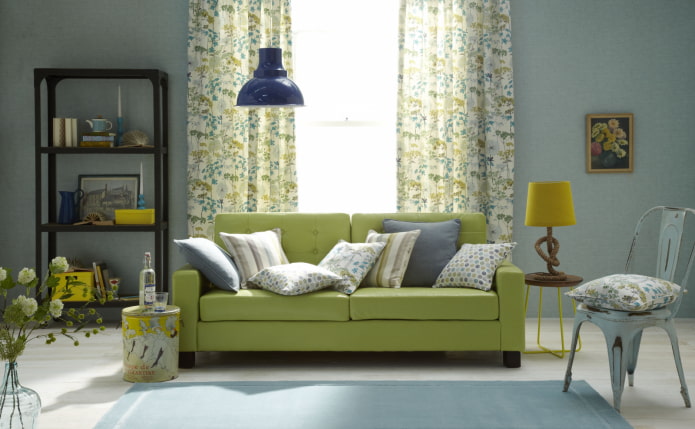
The photo shows a stylish pistachio sofa
Cabinet cabinets are most often limited to kitchen headsets:
- in a classic style with milling, glass inserts, decorative columns;
- in a French village style with scuffs, decorative grilles and cute handles;
- in a modern design with glossy or matte facades without handles.
To prevent the kitchen from looking too green, use pistachio in combination with other colors: brown for the lower tier of cabinets, white for open shelves above, etc.
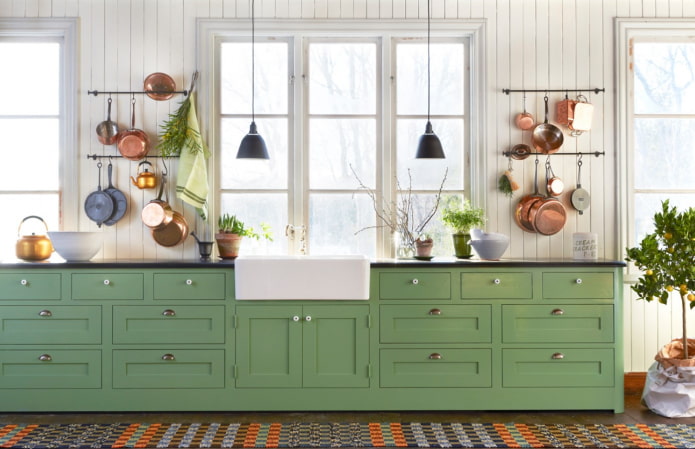
A contrasting dark headset without upper cabinets is located against the background of white walls
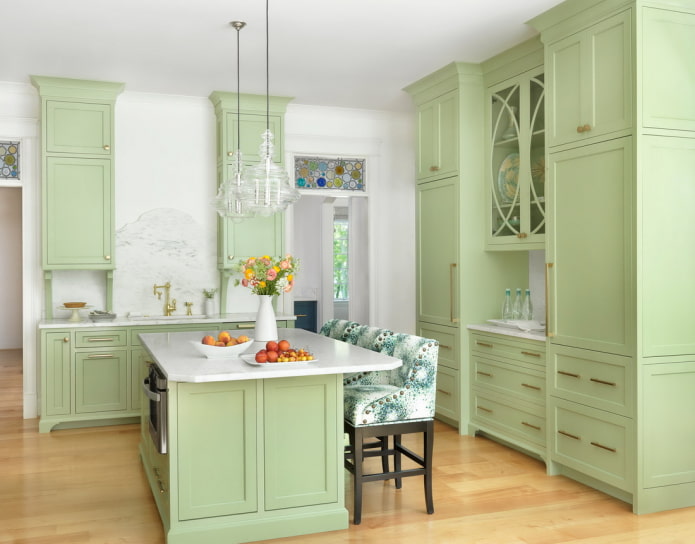
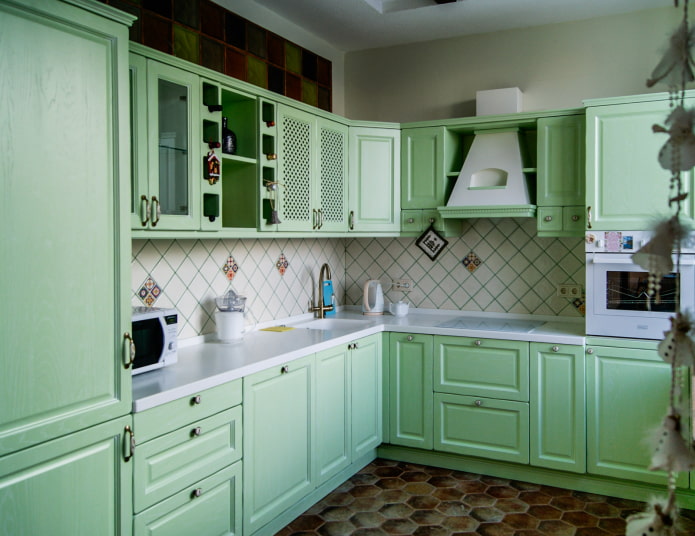
What styles is it best to use?
Since pistachio comes from a pastel palette, the first application that comes to mind is Provence. The phrase “pistachio kitchen” conjures up images of rustic motifs, light carved facades, wooden countertops and retro-style appliances.
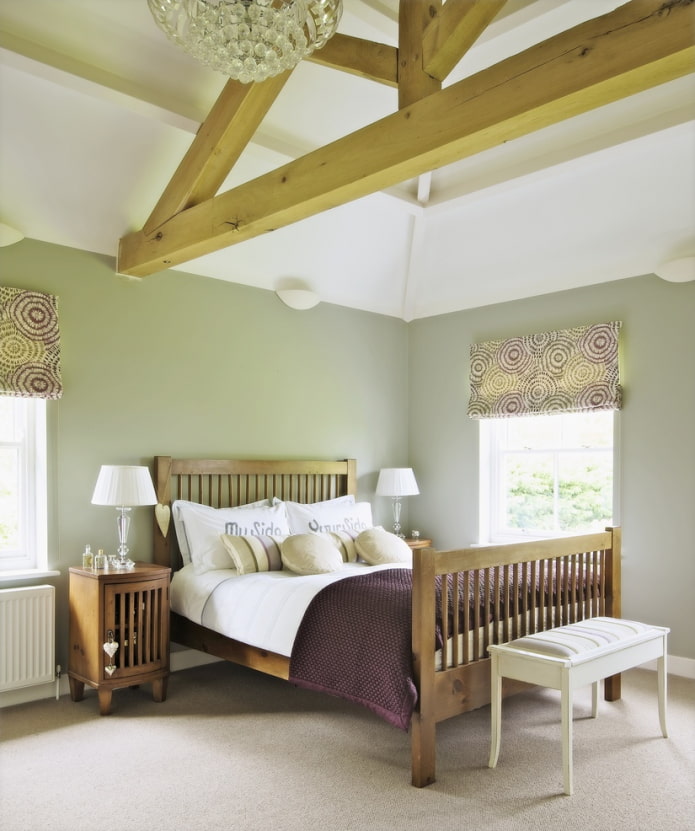
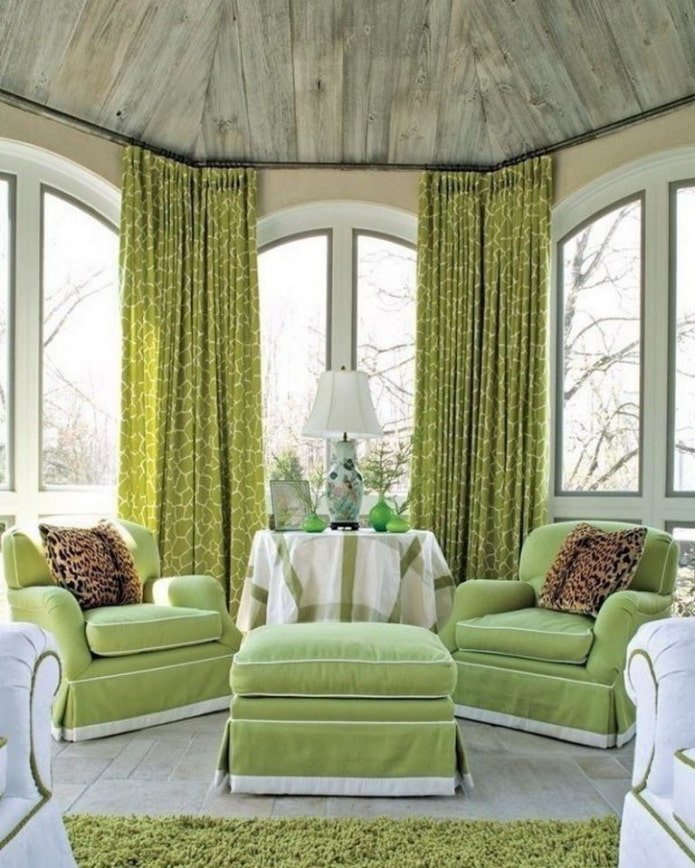
Creating a modern interior requires a cooler tone in moderation, especially when it comes to walls: an admixture of gray makes the soft pistachio more noble and interesting.
The furniture is mostly monochrome, light piping is allowed as a decor for soft sofas or armchairs. Light green is combined with white and black. Wood can be used as a material for finishing the floor or making furniture.
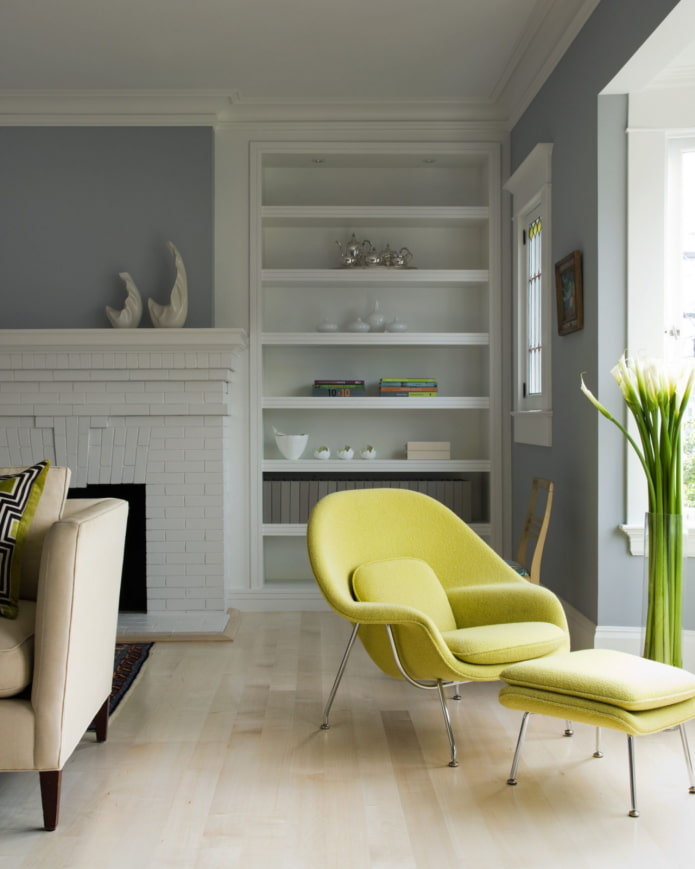
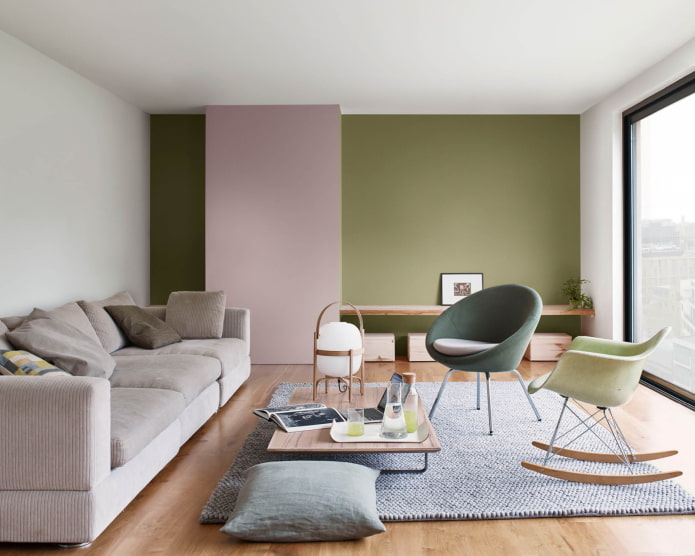
Classics are usually combined with beige or noble brown. For example, green walls, sand chairs, a mahogany sideboard. Prints or patterns on wallpaper, upholstery, textile decorations are acceptable.
If pistachio can lead in the classical direction, then neoclassicism bets on neutral beige and white. Green accents can be: curtains, carpet, sofa cushions.

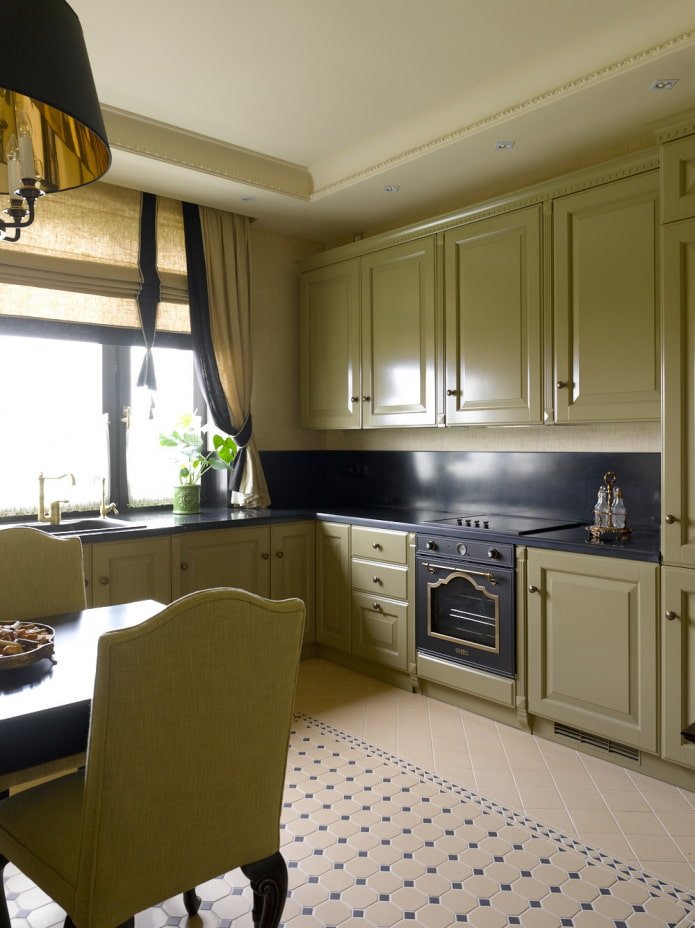
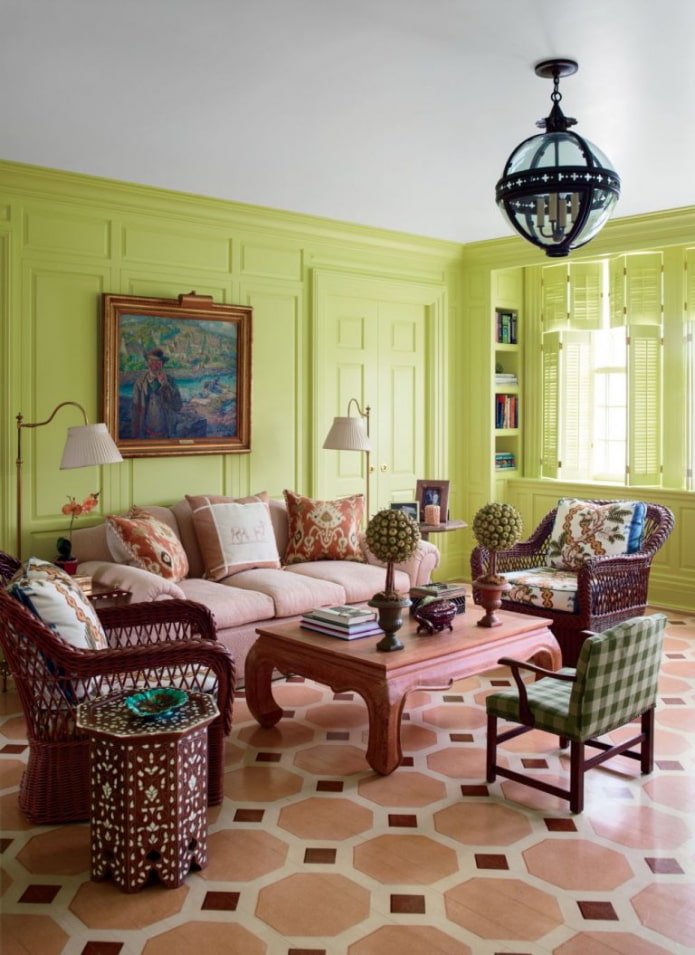
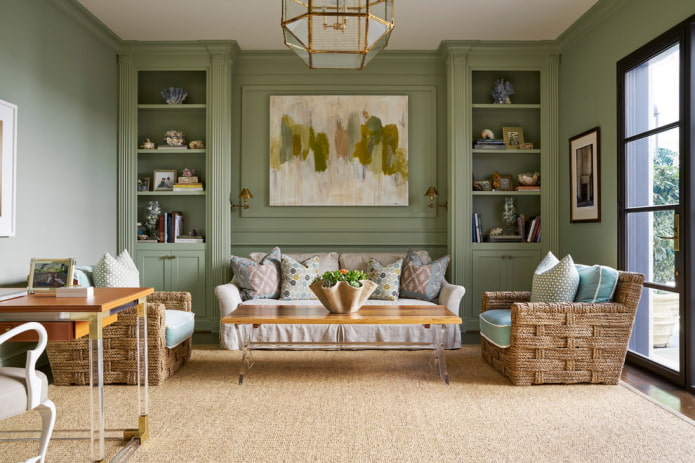
One of the most suitable styles, which often uses natural tones is Scandinavian. Pistachio color goes well with white and light gray colors. To create a cozy interior, use it in doses for textiles, armchairs or small decor.
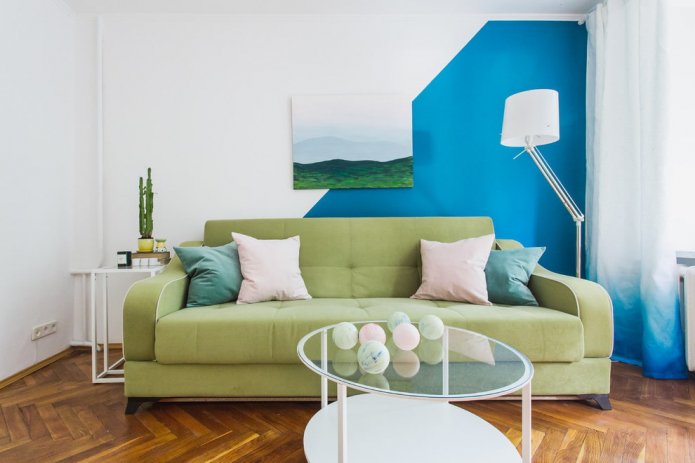
Light shades are suitable for the romantic shabby chic style. Combine with pink, lavender and other pastel colors. In this style, you can safely use the pistachio color to paint the walls or kitchen set.
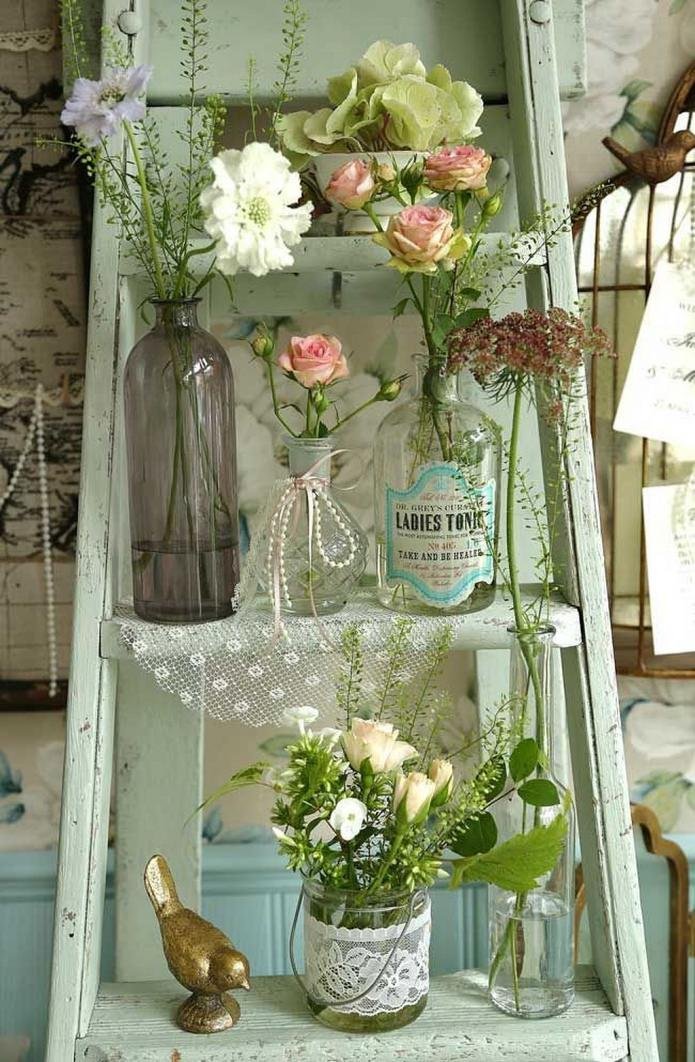

In the minimalist style, pistachio is best used for partial decoration or small furniture. This will be an accent color in a minimalist interior. Deep and cold shades will be preferable to make the interior look fresher and more cozy.
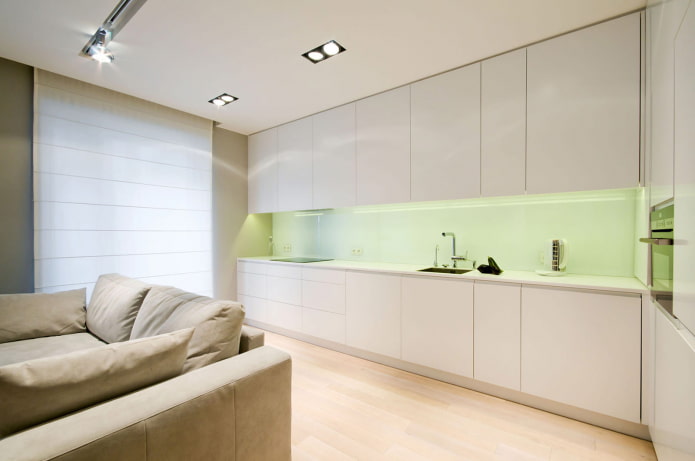

How does it look in the interior?
Pistachio is suitable for decorating any area: from kitchens to children’s rooms.
Pistachio colors in the living room interior are used as in furniture and decoration. If you are creating a monochrome interior, the walls should be lighter, the furniture in medium tones, the darkest ones are accents and accessories. This decoration for the living room is ideal for an evening rest with the whole family.
A bedroom in pistachio color looks advantageous and harmonious: besides, after a hard day at work it will be nice to relax and take a nap. The only nuance: so that after waking up you can feel a surge of strength, dilute the calming green with bright tones: yellow, orange. They should not be visible before going to bed, so it is better to use them on the wall behind the headboard.
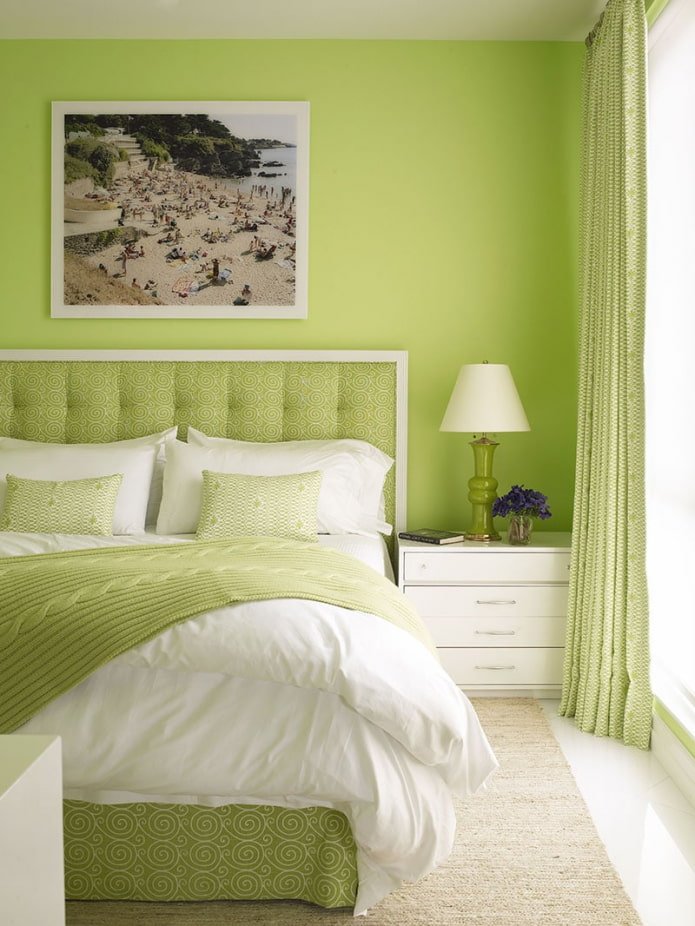
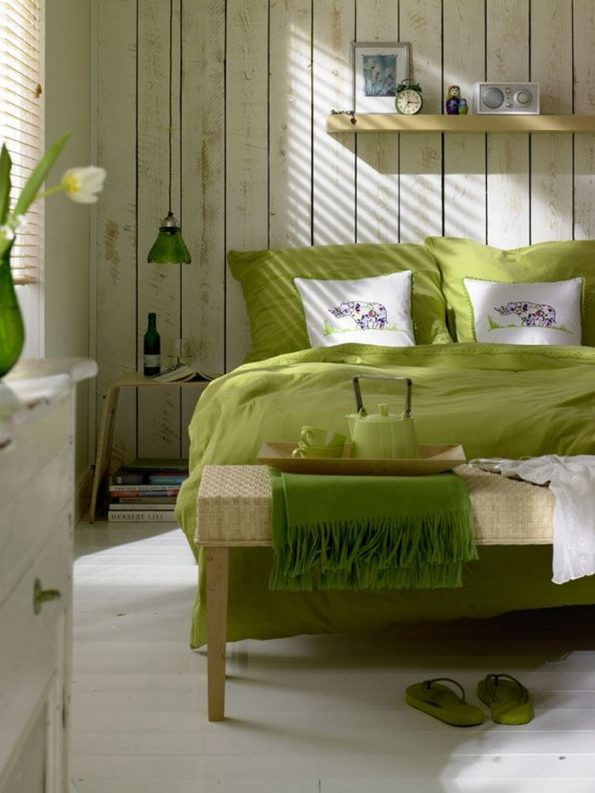
In the kitchen, pistachio will create a cozy and interesting atmosphere, which makes this shade ideal not only for apartment owners, but also for owners of private houses. Moreover, it can be used not only in decoration or furniture, but also in textiles (tablecloth) or tableware – dinner plates, cups.
Combine with white, gray, blue, to make the effect even more noticeable. Warm bright colors will make the kitchen more festive, and restrained ones will add freshness.
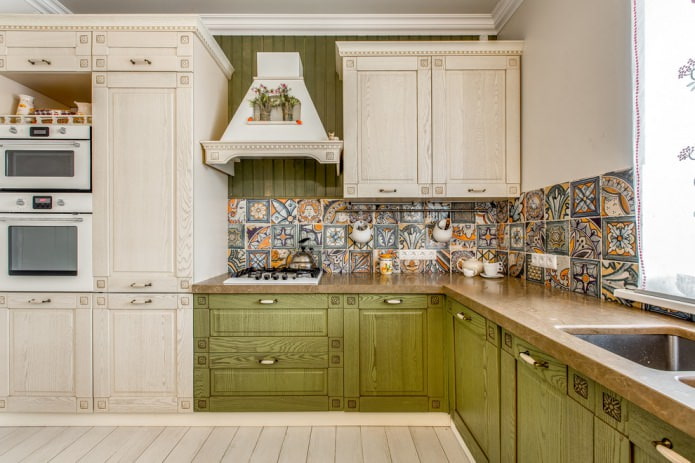
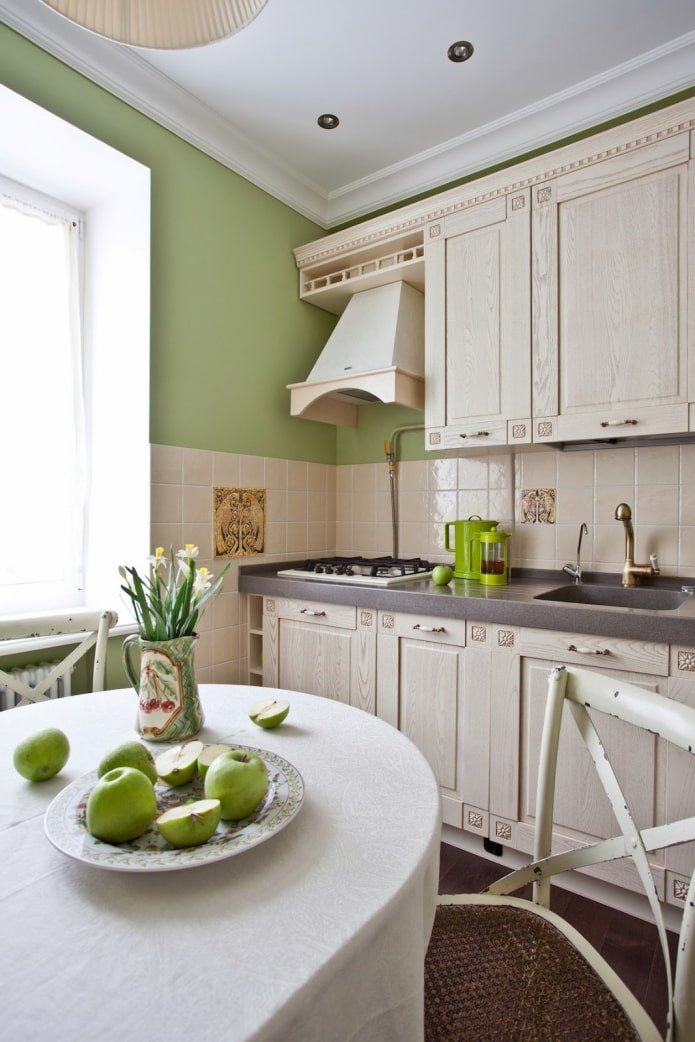
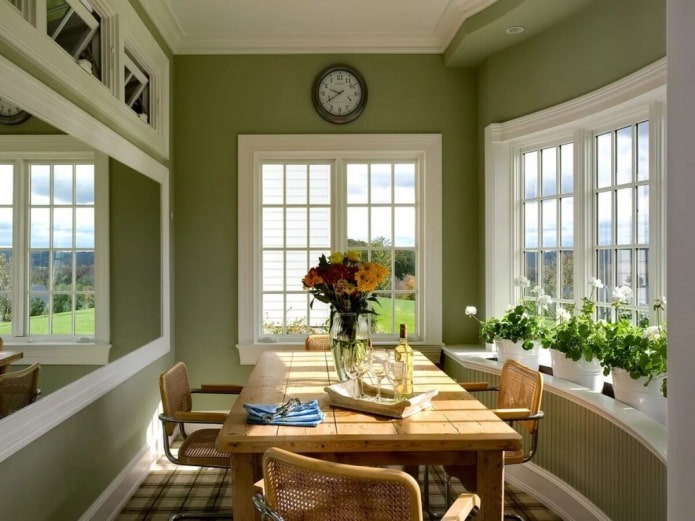
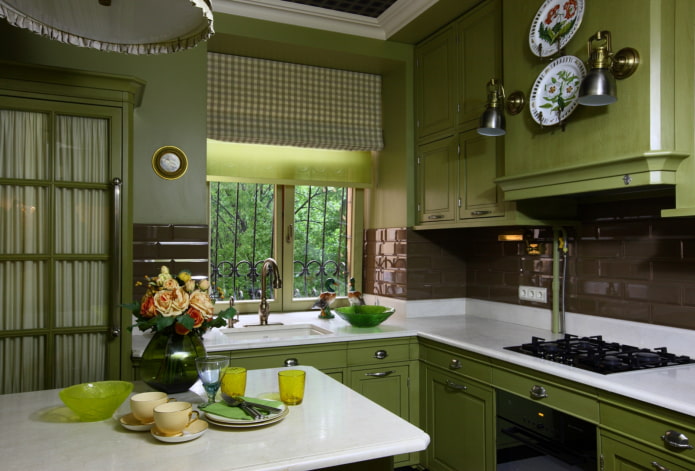
The pistachio bathroom is a great place to relax. It will appeal to those who like to lie in warm water with pleasant music, candles and other SPA attributes. Use additional subdued lighting, add cozy details like a rug – your personal lounge area is ready.
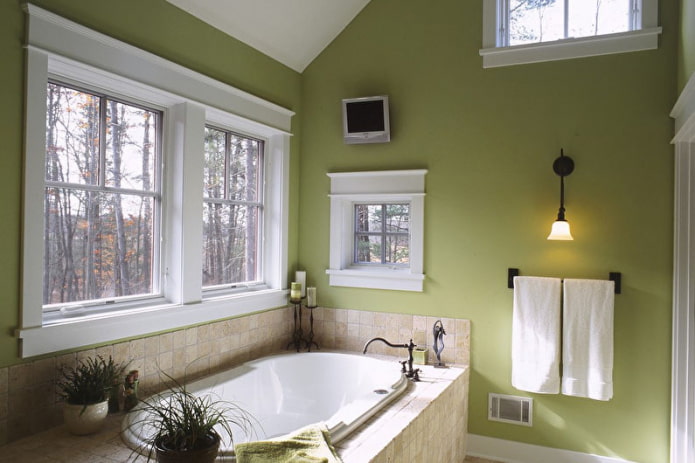
The hallway will look no less impressive in a green outfit: when you come home in the evening, it will be easier for you to leave all your worries and work thoughts outside the door.

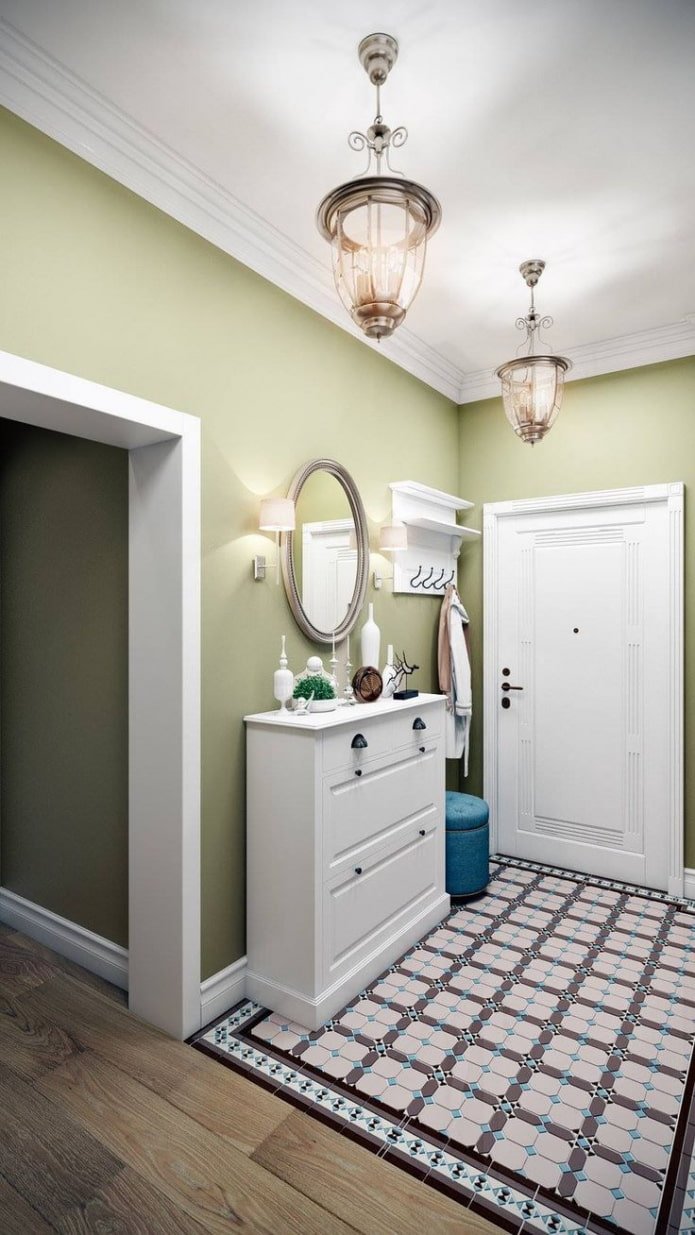
On the balcony, pistachio will harmonize with the greenery outside the window: here you can equip a relaxation area or a study (the green range helps to increase concentration).
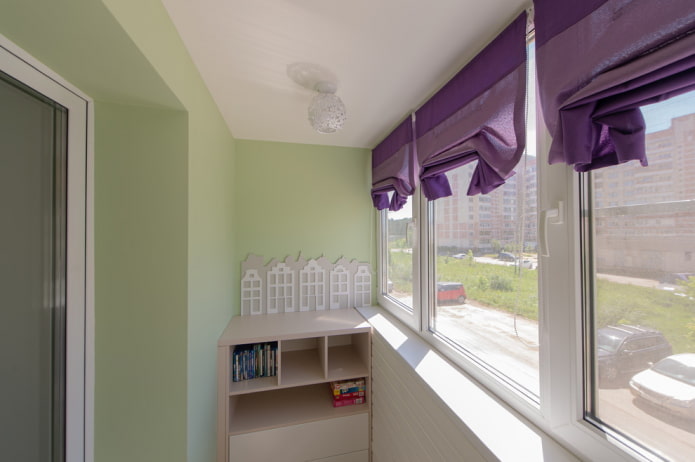

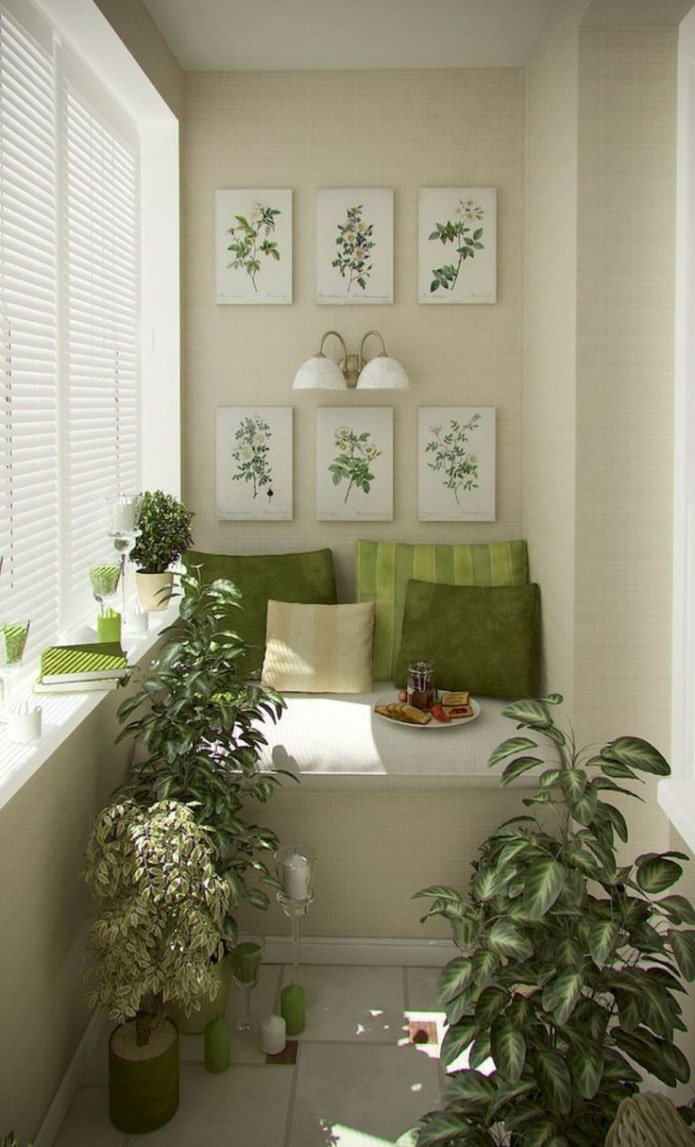
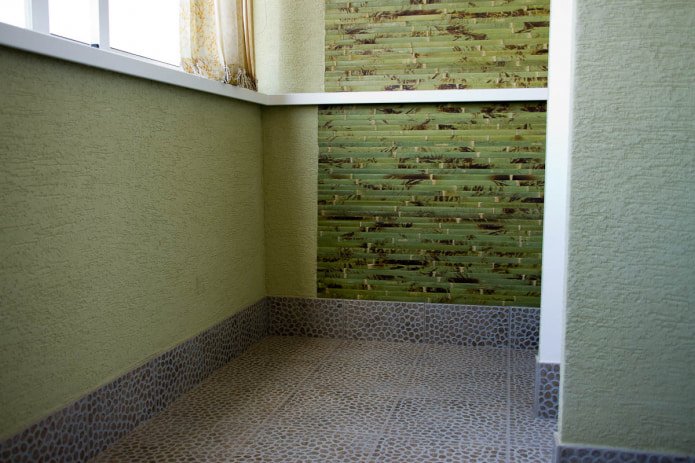
A great solution would be to decorate your office in pistachio colors. Since green color calms and relieves stress, it will be an excellent solution for painting walls.
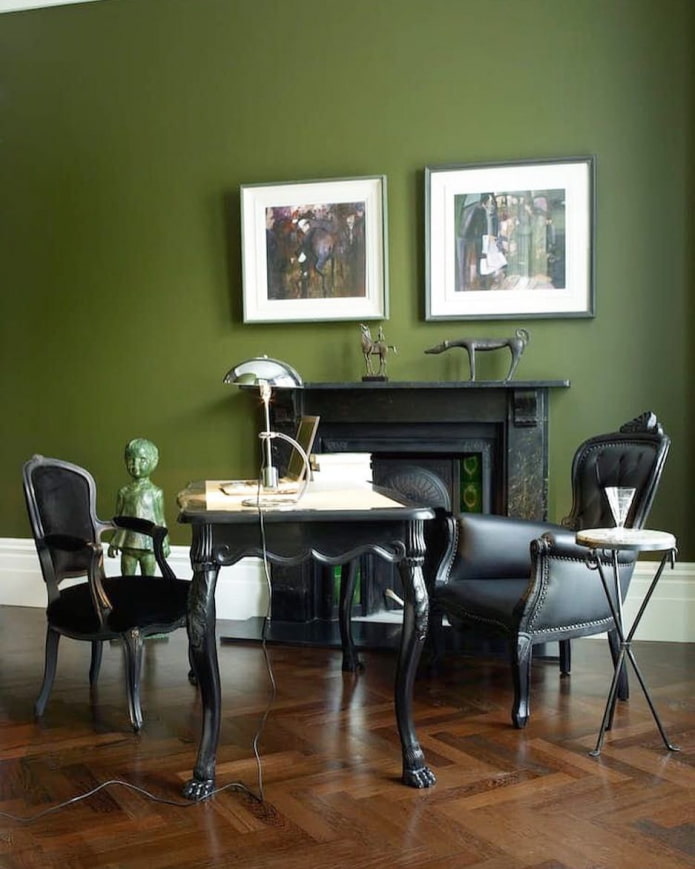
This color is also often used in children’s rooms. The beneficial effect on the child’s psyche will not distract him from his studies, and the interior itself will look restrained and noble.
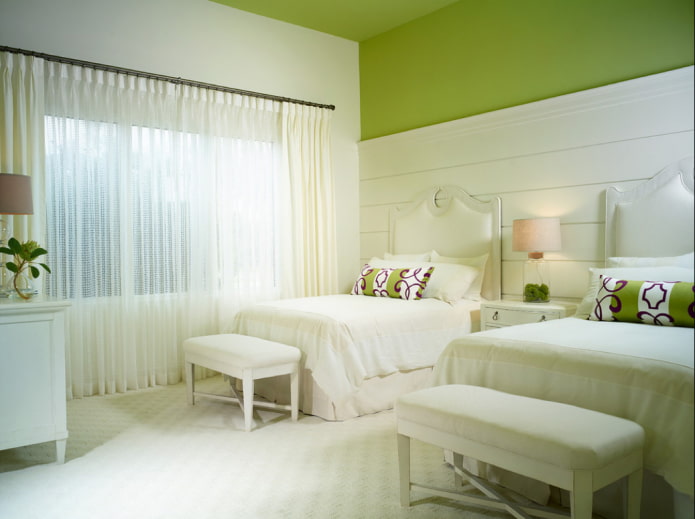

The pistachio interior is an excellent solution for creating an interesting and stylish design. A large number of shades allows you to easily combine it with other colors, and its versatility ensures popularity in various styles.
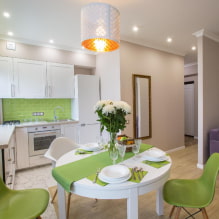
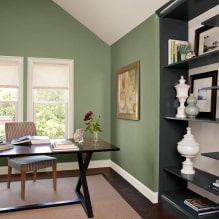
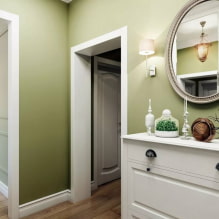
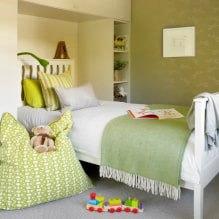
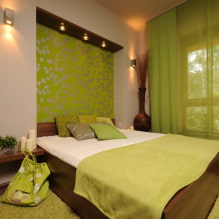
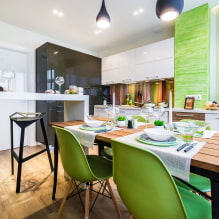
Now reading:
- Your Ultimate Guide to Buying a Used Volvo S90
- Great Solutions for Storing Vegetables in a Compact Kitchen (Stylish and Convenient)
- original ways to use clapboard in the country, easily repeatable by you.
- How to Install Under Cabinet Lighting in Kitchen: Step-by-Step Guide with Video
- TV in the interior: 50+ ideas and photos of design for your living room